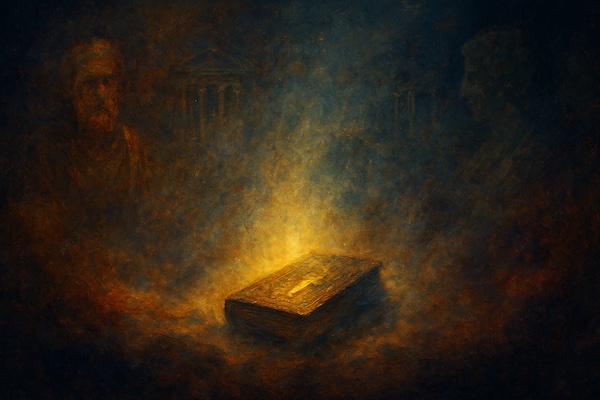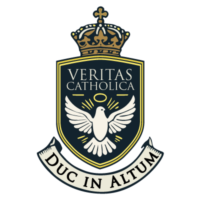The Subtle Danger of Gnostic Thought
In the twilight years of the apostolic age, as the last disciples of Christ’s original followers passed from the scene, a new and dangerous movement began infiltrating Christian communities across the Roman Empire. This movement, which would come to be known as Gnosticism, presented itself not as a rival to Christianity but as its truest, most spiritual expression. Yet beneath its veneer of piety lay a radical reinterpretation—indeed, a complete subversion—of the Gospel message, posing the challenge of Gnosticism to true Christianity.
The early Church Fathers recognised this threat immediately. St. Irenaeus of Lyons, writing around 180 AD, observed with alarm how these new teachers “put forth their own compositions with great audacity, styling them ‘gospels’ while really they deserve no such title.” His monumental work Against Heresies stands as one of our most important early witnesses to this spiritual battle, preserving for posterity both the arguments of the Gnostics and the Church’s decisive refutations.
What made Gnosticism particularly dangerous was its ability to adapt Christian terminology while emptying it of its true meaning. As the late Cardinal Jean Daniélou noted in his seminal work The Theology of Jewish Christianity, the Gnostics were masters of “theological camouflage,” adopting the language of faith while subverting its content. This pattern would repeat itself throughout Church history, making the study of ancient Gnosticism not merely an academic exercise but a vital preparation for recognizing the challenge of Gnosticism to true Christianity in modern times.
As St. Irenaeus of Lyons warned,
Error, indeed, is never set forth in its naked deformity, lest, being thus exposed, it should at once be detected. But it is craftily decked out in an attractive dress, so as, by its outward form, to make it appear to the inexperienced more true than truth itself. (Against Heresies, 1.2).
This deception made Gnosticism particularly insidious, requiring the Church to respond with both theological precision and pastoral firmness.
The Philosophical and Religious Roots of Gnostic Thought
To understand Gnosticism fully, we must examine its complex origins in the religious and philosophical currents of the ancient world. The movement did not emerge ex nihilo but grew from the rich soil of Hellenistic syncretism, drawing elements from multiple traditions while remaining fundamentally alien to all of them.
From Platonism, the Gnostics borrowed the concept of a radical dualism between spirit and matter, though they pushed this division far beyond anything Plato envisioned. While the Athenian philosopher saw the material world as an imperfect reflection of ideal forms, the Gnostics viewed creation as the product of an evil or ignorant demiurge1 — a shocking departure from the Jewish and Christian understanding of a good creation brought into being by a loving God. This theological innovation would become central to the challenge of Gnosticism to true Christianity, as it undermined the Christian doctrine of the goodness of creation.
Persian Zoroastrianism contributed the dramatic cosmic struggle between light and darkness, though the Gnostics transformed this into a narrative of spiritual elites escaping from material bondage rather than the ultimate triumph of good over evil. Jewish mystical traditions, particularly merkabah mysticism and certain apocalyptic texts, provided raw material that the Gnostics reinterpreted through their dualistic lens.
Perhaps most dangerously, early Christian heterodox groups—such as the followers of Cerinthus, Simon Magus, and certain Encratite sects—provided the vocabulary and some of the conceptual framework that Gnostic teachers would exploit. Terms like “pleroma” (fullness), “aeon,” and even “gnosis” itself were adopted and redefined within Gnostic systems, blurring the line between orthodoxy and heresy and making these teachings especially difficult to unmask. The second-century Church Father St. Hippolytus, in his Refutation of All Heresies, meticulously traced how these various influences combined to form the complex Gnostic systems that threatened orthodox Christianity.

The Theology of Gnosticism: Salvation through Secret Knowledge
At its core, Gnosticism was not a single, unified religion but a family of related movements sharing a common worldview: the belief that salvation came not through faith, obedience, or sacramental grace, but through secret knowledge (gnosis) of one’s divine origins.
According to most Gnostic systems, human beings are sparks of divine light trapped in corrupt material bodies. The physical world itself is a prison fashioned by the demiurge1, a lower deity ignorant of the true God. Jesus, in this schema, becomes not the incarnate Son of God who redeems humanity through His death and resurrection, but a heavenly emissary who awakens the elect to their true nature and teaches them how to escape the material world.
This view necessitated a rejection of key Christian doctrines: the goodness of creation, the Incarnation, the bodily Resurrection, and the sacramental life of the Church. It also fostered an elitist spirituality in which only the spiritually “awake” could be saved—a sharp contrast to the catholic (universal) message of the Gospel. This is why the challenge of Gnosticism to true Christianity remains as urgent today as it did in the early centuries, requiring Christians to reaffirm these foundational truths.
The Church’s Response: Clarity through Creed and Canon
The threat of Gnosticism forced the early Church to clarify and articulate her teachings with greater precision. In response to Gnostic reinterpretations of Scripture, the Church solidified the canon of the New Testament, recognising the apostolic origins and orthodoxy of certain texts while rejecting others.
The development of the Rule of Faith—a summary of apostolic teaching handed down through the bishops—provided a standard against which novel doctrines could be judged. This eventually found expression in the early creeds, especially the Apostles’ Creed and the Nicene Creed, which explicitly affirmed the goodness of creation, the reality of the Incarnation, and the hope of bodily resurrection. These doctrinal clarifications directly addressed the challenge of Gnosticism to true Christianity, preserving the integrity of the Christian faith.
Church Fathers like Irenaeus, Tertullian, and Hippolytus composed exhaustive refutations of Gnostic errors, not merely to win arguments but to safeguard the faithful from spiritual deception. Their works remain invaluable today for understanding how the Church responds to heresies: not by innovation, but by deeper fidelity to the deposit of faith.
Modern Echoes: Gnostic Assumptions in Contemporary Culture
Though ancient Gnosticism as a religious system is long dead, its core assumptions live on in many aspects of modern culture. In conversations with modern seekers, I’ve often found Gnostic ideas lurking behind phrases like “spiritual but not religious” or “my truth.” The rejection of the material world, the exaltation of subjective experience, and the suspicion of external authority are all deeply Gnostic instincts. These echoes of the challenge of Gnosticism to true Christianity are particularly pertinent today, as we see the rise of individualism and a growing disdain for established religious traditions.
Why “spiritual but not religious” or “my truth,” is Gnostic at Heart
Subjectivism and Relativism: Gnostic thought often emphasises subjective, personal knowledge (gnosis) as the key to salvation, rather than an objective, communal truth. Gnostics believed that truth was hidden from the masses and only accessible to a select group of enlightened individuals. Similarly, the modern idea of “my truth” suggests that truth is subjective and individualised, rather than universal or objective. This is a hallmark of Gnostic thinking—truth is not something grounded in shared reality or tradition but is rather constructed by the individual.
Escape from the Material World: Gnosticism traditionally rejects the physical world as something inferior or even evil, created by the ignorant or malevolent demiurge. The modern spiritual seeker might be influenced by the idea of transcending ordinary, material existence, emphasising an inner spiritual journey over engagement with the material world and religious community. This resembles the Gnostic desire to escape the confines of physical reality and gain spiritual enlightenment apart from the body or material concerns.
Individualism Over Community: Gnosticism often fostered an elitist mindset, where only those with access to secret knowledge could be truly “saved.” Modern phrases like “spiritual but not religious” reflect a similar disdain for communal religious structures in favour of personal, individualised spirituality. It reduces faith to a private, personal affair, which is a stark contrast to the communal aspect of traditional Christianity.
Why It Is Wrong From a Catholic Perspective
Objective Truth: The Catholic Church teaches that truth is not subjective, but rather rooted in objective reality—specifically, the teachings of Christ, which are preserved through Sacred Scripture and Sacred Tradition. The idea that truth is “my truth” directly contradicts this. Catholicism maintains that salvation and understanding of God come from aligning oneself with revealed truth, not a personal or constructed truth.
The Incarnation and the Material World: The Church rejects Gnostic dualism, which sees the material world as inherently corrupt or evil. Catholicism affirms the goodness of creation, as stated in Genesis (“And God saw that it was good… very good”). The Incarnation of Jesus Christ—the Word becoming flesh—was a direct affirmation that the material world and the human body are not inherently flawed. Christ’s resurrection also underscores that the ultimate goal is the glorification of the body, not its rejection.
The Importance of the Church Community: The Catholic Church teaches that salvation is a communal journey, not just an individual pursuit. The Church is the Body of Christ, and it is through participation in the sacraments and life of the Church that one grows in holiness and attains salvation. The “spiritual but not religious” mindset often rejects these communal and sacramental aspects of the faith, instead focusing on a solitary, personal journey. Catholicism teaches that true spirituality is inseparable from participation in the Church and its sacraments, where Christ’s grace is communicated to all believers.
Agnosticism and the Hidden God: While Gnosticism held that true knowledge of God was hidden and only accessible to the spiritually enlightened, Catholicism teaches that God desires all people to know Him and be saved. The mystery of God’s plan for salvation is not hidden in an elitist, inaccessible way but is revealed through Christ, the Church, and the sacraments. The Catholic understanding of revelation affirms that God’s truth is meant for everyone, not just an enlightened few.
In summary, the “spiritual but not religious” and “my truth” sentiments echo Gnostic tendencies by focusing on individual, subjective experience over communal worship and objective truth. From a Catholic perspective, these ideas are problematic because they separate personal spirituality from the objective truth revealed in Christ and diminish the role of the Church and sacraments in the path to salvation.
Even within Christian communities, one finds traces of Gnostic influence—in the assumption that salvation is primarily about escaping the body and “going to heaven,” or in the devaluation of the sacraments as mere symbols rather than real, physical encounters with grace. This is not true Christianity but a subtle drift into Platonic dualism. The Church has always taught that the body and soul form a unity and that our ultimate destiny is not disembodied bliss but the resurrection of the body and the life of the world to come.
In a world increasingly seduced by digital experiences, abstract spirituality, and self-generated meaning, the ancient battle between orthodoxy and Gnosis continues. As it was in the second century, so it is in the twenty-first: truth must be loved, defended, and lived.
The Enduring Relevance of Gnosticism
The persistent allure of Gnosticism throughout history highlights its deep psychological and spiritual appeal. It provides an escape from the difficulties of the material world and promises an individual path to spiritual enlightenment. But this seductive heresy—be it in ancient times or in the forms it takes today—undermines the Christian understanding of creation, redemption, and salvation.
As Catholics, we must remain vigilant against these subtle influences, which often appear under the guise of “spirituality” or “personal truth.” The Church calls us to embrace the full richness of our faith, with all its communal and sacramental dimensions, and to recognise that true knowledge of God is not hidden away for a select few, but is freely offered to all in the person of Jesus Christ.
Footnotes
- In Gnostic thought, the demiurge is the ignorant or malevolent creator of the material world—distinct from and inferior to the true, transcendent God. While in Platonic philosophy the term simply referred to a divine craftsman who shaped the cosmos using eternal forms, Gnostics used the term to describe a false god who trapped divine sparks (human souls) in corrupt physical bodies. This demiurge, often identified with the God of the Old Testament, was seen as a cosmic jailer, standing in opposition to the spiritual liberation offered by Gnostic “knowledge.” ↩︎



